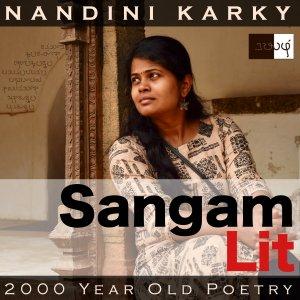Sangam Lit

Aganaanooru 35 – A prayer for her
In this episode, we listen to a mother’s fervent prayer, as depicted in Sangam Literary work, Aganaanooru 35, penned by Kudavayil Keerathanaar. Set in the ‘Paalai’ or ‘Drylands landscape’, the verse depicts the life and worship of an ancient tribe, and also, the lament and love of a mother.
ஈன்று புறந்தந்த எம்மும் உள்ளாள்,
வான் தோய் இஞ்சி நல் நகர் புலம்ப
தனி மணி இரட்டும் தாளுடைக் கடிகை,
நுழை நுதி நெடு வேல், குறும் படை மழவர்
முனை ஆத் தந்து, முரம்பின் வீழ்த்த
வில் ஏர் வாழ்க்கை விழுத் தொடை மறவர்
வல் ஆண் பதுக்கைக் கடவுட் பேண்மார்,
நடுகல் பீலி சூட்டி, துடிப்படுத்து,
தோப்பிக் கள்ளொடு துரூஉப் பலி கொடுக்கும்
போக்கு அருங் கவலைய புலவு நாறு அருஞ் சுரம்
துணிந்து, பிறள் ஆயினள்ஆயினும், அணிந்து அணிந்து,
ஆர்வ நெஞ்சமொடு ஆய் நலன் அளைஇ, தன்
மார்பு துணையாகத் துயிற்றுகதில்ல
துஞ்சா முழவின் கோவற் கோமான்
நெடுந் தேர்க் காரி கொடுங்கால் முன்துறை,
பெண்ணை அம் பேரியாற்று நுண் அறல் கடுக்கும்
நெறி இருங் கதுப்பின் என் பேதைக்கு,
அறியாத் தேஎத்து ஆற்றிய துணையே!
We get to meet with the mother in this trip to the drylands, and here are her words, at the juncture when her daughter has eloped away with the man:
“Thinking not of me, who gave birth and raised her, leaving the fine mansion with sky-soaring walls to lament, she has left to the formidable drylands, where small bands of ‘Mazhavars’, bearing tall spears with sharp edges, and firm necks, around which bells ring aloud, after recovering their stolen cattle at the battlefront, build stone memorials for those great and able warriors, known for their lives of ploughing with their bows, the ones, who defeated the enemies and had fallen to their death, see them as their gods and pray for their protection, by adorning their hero stones with peacock feathers, beating drums, offering along with rice wine, a sacrifice of sheep, in those flesh-reeking, deserted paths. To such a place, she has left so daringly, becoming a stranger to us. My naive daughter, who has wavy dark tresses, akin to the fine sands of the great Pennai river, in the shore of the Kodunkaal town, ruled by ‘Kaari’, the one who wields tall chariots, the king of Kovalur, where drums sleep not, was taken away to an unknown land by that companion of hers. Praising her again and again, delighting in her fine beauty, let him always offer his chest, for her to sleep sweetly!”
Listening to the prayers of hero stone worshippers, let’s take a walk in the drylands and understand this mother’s heart. Mother starts by lamenting how the lady had no thought about her mother, who had given birth and raised her with much love. She says this because the lady had left their wealthy mansion and parted away to the drylands, in the company of a young man. She then talks about a tribe of people called the ‘Mazhavars’, who are skilled at the battlefield, and are adept at recovering their stolen cattle. In any war, there would be losses, and even these brave soldiers, who fought and defeated the enemy, might succumb in the battle. In memory of those great warriors, the Mazhavars erect hero stones, tie them with peacock feathers, offer rice wine and sacrifice sheep as part of their prayers to these people who lived and defended them. Why has mother seemingly forgotten her girl and started talking about a random tribe? Only to say in those deserted paths, where these Mazhavars offer their prayers and spread the scent of flesh in the air, her daughter now walks with the man.
After that description of the drylands, mother mulls over how her own precious daughter had become a stranger to her because of her act of eloping away. Thinking of the beauty of her little girl, mother is reminded of the wavy tresses, which she then places in parallel to the sands on the shore of the ‘Pennai’ river in a town called ‘Kodunkaal’ ruled by the King of Kovalur, ‘Kaari’. Isn’t it interesting how history and geography are presented as a package in that description of the silt-filled sands of a river shore and the king who rules it? Returning, we find mother, after singing praises of her girl’s beauty, now concluding with a sincere wish that the man, who took away her girl, would always be loving to her, keeping her happy by celebrating her, and delighting in her beauty and most of all, offering his chest for her precious girl to attain a comforting sleep, every single day!
What should we focus on? Should we speak about a mother’s love that overlooks all hurt experienced and wishes only for the welfare of her child? Should we delight in that comparison of a South Indian woman’s wavy tresses with the sand patterns of the River ‘Pennai’? Or, should we focus on those insightful anthropological details of ancestor worship, a commonality among most ancient cultures, and possibly, the origin of religion itself? Perhaps, we should simply whisper a word of gratitude to these ancient Sangam poets, who have shown us the ocean in their little drops of words!






 Visit Podcast Website
Visit Podcast Website RSS Podcast Feed
RSS Podcast Feed Subscribe
Subscribe
 Add to MyCast
Add to MyCast